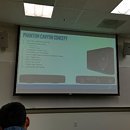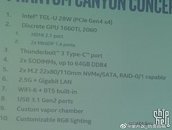- Joined
- Oct 9, 2007
- Messages
- 47,857 (7.38/day)
- Location
- Dublin, Ireland
| System Name | RBMK-1000 |
|---|---|
| Processor | AMD Ryzen 7 5700G |
| Motherboard | Gigabyte B550 AORUS Elite V2 |
| Cooling | DeepCool Gammax L240 V2 |
| Memory | 2x 16GB DDR4-3200 |
| Video Card(s) | Galax RTX 4070 Ti EX |
| Storage | Samsung 990 1TB |
| Display(s) | BenQ 1440p 60 Hz 27-inch |
| Case | Corsair Carbide 100R |
| Audio Device(s) | ASUS SupremeFX S1220A |
| Power Supply | Cooler Master MWE Gold 650W |
| Mouse | ASUS ROG Strix Impact |
| Keyboard | Gamdias Hermes E2 |
| Software | Windows 11 Pro |
Intel is working on its next generation gaming-grade NUC, codenamed "Phantom Canyon." When it comes out some time in 2020-21, it will feature Intel's 10 nm+ "Tiger Lake" SoC. Intel detailed this and more in a leaked presentation to industry partners. It describes the launch of of the company's "Ghost Canyon" NUC in Fall 2019 to succeed the current "Hades Canyon" gaming NUC. This box features a Core i9-9980HK processor and discrete graphics options. It will be succeeded in 2020-21 (late 2020 or sometime 2021), by the "Phantom Canyon" NUC that's in development.
The "Phantom Canyon" NUC is powered by a 28 W 10 nm+ "Tiger Lake-U" SoC that features PCI-Express gen 4. The package also implements Intel's "Gen 12" graphics processor that's derived from the Xe architecture it's currently working on, according to Chinese publication PTTWeb. The NUC will also feature discrete graphics options in the price-range of the current GTX 1660 Ti and RTX 2060 ($299 to $349). In related news, we see subtle hints that Intel will give its chipset bus a major update in future generations of its desktop and mobile platforms. Apparently, future platforms could feature DMI spread over 8 lanes as opposed to 4 on current platforms, besides the update to PCIe gen 4. This quadrupling in bandwidth compared to DMI 3.0 (PCIe 3.0 x4) is necessitated by the growth in bandwidth-hungry devices such as NVMe SSDs, external Thunderbolt 3 graphics cards, USB 3.2 flash drives, etc.



View at TechPowerUp Main Site
The "Phantom Canyon" NUC is powered by a 28 W 10 nm+ "Tiger Lake-U" SoC that features PCI-Express gen 4. The package also implements Intel's "Gen 12" graphics processor that's derived from the Xe architecture it's currently working on, according to Chinese publication PTTWeb. The NUC will also feature discrete graphics options in the price-range of the current GTX 1660 Ti and RTX 2060 ($299 to $349). In related news, we see subtle hints that Intel will give its chipset bus a major update in future generations of its desktop and mobile platforms. Apparently, future platforms could feature DMI spread over 8 lanes as opposed to 4 on current platforms, besides the update to PCIe gen 4. This quadrupling in bandwidth compared to DMI 3.0 (PCIe 3.0 x4) is necessitated by the growth in bandwidth-hungry devices such as NVMe SSDs, external Thunderbolt 3 graphics cards, USB 3.2 flash drives, etc.



View at TechPowerUp Main Site









